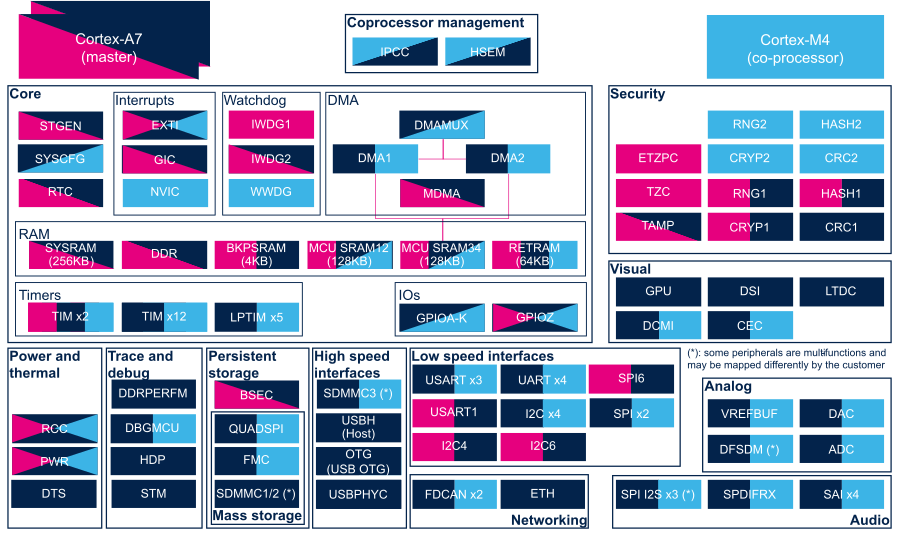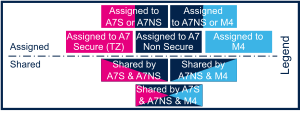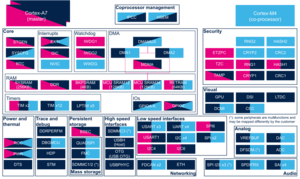This article lists all internal peripherals embedded in STM32MP15 device and shows the assignment possibilities to the runtime contexts for each one of them.
Via this article, you can also access to individual peripheral articles in which information related to the overview and configuration can be found.
1. Internal peripherals overview[edit | edit source]
The figure below shows all peripherals embedded in STM32MP15 device, grouped per functional domains that are reused in many places of this wiki to structure the articles.
Several runtime contexts exist on STM32MP15 device[1], corresponding to the different Arm cores and associated security modes:
- Arm dual core Cortex-A7 secure (Trustzone), running a Secure Monitor or Secure OS like OP-TEE
- Arm dual core Cortex-A7 non secure , running Linux
- Arm Cortex-M4 (non-secure), running STM32Cube
Some peripherals can be strictly assigned to one runtime context: this is the case for most of the peripherals, like USART or I2C.
Other ones can be shared between several runtime contexts: this is the case for system peripherals, like PWR or RCC.
The legend below shows how assigned and shared peripherals are identified in the assignment diagram that follows:
Both the diagram below and the following summary table (in Internal peripherals assignment chapter below) are clickable in order to jump to each peripheral overview articles and get more detailed information (like software frameworks used to control them). They list STMicroelectronics recommendations. The STM32MP15 reference manual [2] may expose more possibilities than what is shown here.

2. Internal peripherals assignment[edit | edit source]
Check boxes illustrate the possible peripheral allocations supported by STM32 MPU Embedded Software:
- ☐ means that the peripheral can be assigned (☑) to the given runtime context.
- ✓ is used for system peripherals that cannot be unchecked because they are statically connected in the device.
Refer to How to assign an internal peripheral to a runtime context for more information on how to assign peripherals manually or via STM32CubeMX.
The present chapter describes STMicroelectronics recommendations or choice of implementation. Additional possiblities might be described in STM32MP15 reference manuals.
3. Article purpose[edit | edit source]
The purpose of this article is to:
- briefly introduce the STGEN peripheral and its main features
- indicate the level of security supported by this hardware block
- explain how it can be allocated to the runtime contexts and linked to the corresponding software components
- explain, when necessary, how to configure the STGEN peripheral.
4. Peripheral overview[edit | edit source]
The STGEN peripheral provides the reference clock used by the Arm® Cortex®-A7 generic timer for its counters, including the system tick generation.
It is clocked by ACLK (the AXI bus clock), so caution is needed when this clock is changed; otherwise the operating system (running on the Cortex-A7) might run with a varying reference clock.
4.1. Features[edit | edit source]
Refer to the STM32MP13 reference manuals or STM32MP15 reference manuals for the complete list of features, and to the software components, introduced below, to see which features are implemented.
4.2. Security support[edit | edit source]
The STGEN is a single-instance peripheral that can be accessed via the two following register sets:
- STGENC for the control. That is, a secure port (under ETZPC control).
- STGENR for the read-only access. That is, a non secure port.
5. Peripheral usage and associated software[edit | edit source]
5.1. Boot time[edit | edit source]
The STGEN is first initialized by the ROM code, then updated by the FSBL (see Boot chain overview) once the clock tree is set up.
5.2. Runtime[edit | edit source]
5.2.1. Overview[edit | edit source]
Linux® and OP-TEE use the Arm Cortex-A7 generic timer that gets its counter from the STGEN, but this is transparent at run time.
Hence there is no runtime allocation decision for this peripheral: both contexts are selected by default.
5.2.2. Software frameworks[edit | edit source]
5.2.2.1. On STM32MP13x lines  [edit | edit source]
[edit | edit source]
| Domain | Peripheral | Runtime allocation | Comment | |||
|---|---|---|---|---|---|---|
| Instance | Cortex-A7 secure (OP-TEE) |
Cortex-A7 non-secure (Linux) |
Cortex-M4 (STM32Cube) | |||
| Analog | ADC | ADC | ☐ | ☐ | Assignment (single choice) | |
| Analog | DAC | DAC | ☐ | ☐ | Assignment (single choice) | |
| Analog | DFSDM | DFSDM | ☐ | ☐ | Assignment (single choice) | |
| Analog | VREFBUF | VREFBUF | ☐ | Assignment (single choice) | ||
| Audio | SAI | SAI1 | ☐ | ☐ | Assignment (single choice) | |
| SAI2 | ☐ | ☐ | Assignment (single choice) | |||
| SAI3 | ☐ | ☐ | Assignment (single choice) | |||
| SAI4 | ☐ | ☐ | Assignment (single choice) | |||
| Audio | SPDIFRX | SPDIFRX | ☐ | ☐ | Assignment (single choice) | |
| Coprocessor | IPCC | IPCC | ☑ | ☑ | Shared (none or both) | |
| Coprocessor | HSEM | HSEM | ✓ | ✓ | ✓ | |
| Domain | Peripheral | Software components | Comment | |
|---|---|---|---|---|
| OP-TEE | Linux | |||
| Core | STGEN | see comment | see comment | Not applicable as the STGEN peripheral is configured at boot time and not accessed at runtime |
5.2.2.2. On STM32MP15x lines  [edit | edit source]
[edit | edit source]
| Domain | Peripheral | Software components | Comment | ||
|---|---|---|---|---|---|
| OP-TEE | Linux | STM32Cube | |||
| Core | STGEN | see comment | see comment | Not applicable as the STGEN peripheral is configured at boot time and not accessed at runtime | |
5.2.3. Peripheral configuration[edit | edit source]
5.2.4. Peripheral assignment[edit | edit source]
5.2.4.1. On STM32MP13x lines  [edit | edit source]
[edit | edit source]
Check boxes illustrate the possible peripheral allocations supported by STM32 MPU Embedded Software:
- ☐ means that the peripheral can be assigned (☑) to the given runtime context.
- ⬚ means that the peripheral can be assigned to the given runtime context, but this configuration is not supported in STM32 MPU Embedded Software distribution.
- ✓ is used for system peripherals that cannot be unchecked because they are statically connected in the device.
Refer to How to assign an internal peripheral to a runtime context for more information on how to assign peripherals manually or via STM32CubeMX.
The present chapter describes STMicroelectronics recommendations or choice of implementation. Additional possiblities might be described in STM32MP13 reference manuals.
| Domain | Peripheral | Runtime allocation | Comment | ||
|---|---|---|---|---|---|
| Instance | Cortex-A7 secure (OP-TEE) |
Cortex-A7 non-secure (Linux) | |||
| Core | STGEN | STGEN | ✓ | ✓ | |
5.2.4.2. On STM32MP15x lines  [edit | edit source]
[edit | edit source]
Click on the right to expand the legend...
| Domain | Peripheral | Runtime allocation | Comment | |||
|---|---|---|---|---|---|---|
| Instance | Cortex-A7 secure (OP-TEE) |
Cortex-A7 non-secure (Linux) |
Cortex-M4 (STM32Cube) | |||
| Core | STGEN | STGEN | ✓ | ✓ | ||
6. References[edit | edit source]
STM32MP15 SYSCFG internal peripheral
Core/DMA
DMA
DMA1
☐
☐
Assignment (single choice)
DMA2
☐
☐
Assignment (single choice)
Core/DMA
DMAMUX
DMAMUX
☐
☐
Shareable (multiple choices supported)
Core/Interrupts
GIC
GIC
✓
✓
Core/Interrupts
NVIC
NVIC
✓
Core/RAM
MCU SRAM
SRAM1
☐
☐
☐
Assignment (between A7 S and A7 NS / M4)
Shareable (between A7 NS and M4)
SRAM2
☐
☐
☐
Assignment (between A7 S and A7 NS / M4)
Shareable (between A7 NS and M4)
SRAM3
☐
☐
☐
Assignment (between A7 S and A7 NS / M4)
Shareable (between A7 NS and M4)
SRAM4
☐
☐
☐
Assignment (between A7 S and A7 NS / M4)
Shareable (between A7 NS and M4)
Core/RAM
RETRAM
RETRAM
☐
☐
☐
Assignment (single choice)
Core/Watchdog
IWDG
IWDG1
☐
IWDG2
☐
☐
Shared (none or both):
- Cortex-A7 non secure for reload
- Cortex-A7 secure for early interrupt handling
Core/Watchdog
WWDG
WWDG
☐
High speed interface
USBH (USB Host)
USBH (USB Host)
☐
High speed interface
USBPHYC (USB HS PHY controller)
USBPHYC (USB HS PHY controller)
☐
Low speed interface
I2C
I2C1
☐
☐
Assignment (single choice)
I2C2
☐
☐
Assignment (single choice)
I2C3
☐
☐
Assignment (single choice)
I2C4
☐
☐
Assignment (single choice).
Used for PMIC control on ST boards.
I2C5
☐
☐
Assignment (single choice)
I2C6
☐
☐
Assignment (single choice)
Mass storage
QUADSPI
QUADSPI
☐
☐
Assignment (single choice)
Mass storage
SDMMC
SDMMC1
☐
SDMMC2
☐
SDMMC3
☐
☐
Assignment (single choice)
Networking
ETH
ETH
☐
Assignment (single choice)
Power & Thermal
DTS
DTS
☐
Power & Thermal
PWR
PWR
✓
✓
✓
STM32MP15 RCC internal peripheral
STM32MP15 CRYP internal peripheral
STM32MP15 ETZPC internal peripheral
STM32MP15 HASH internal peripheral
STM32MP15 RNG internal peripheral
STM32MP15 TAMP internal peripheral
Trace & Debug
DBGMCU
DBGMCU
No assignment
Trace & Debug
HDP
HDP
☐
ETM internal peripheral
STM internal peripheral
Visual
CEC
CEC
☐
☐
Assignment (single choice)
Visual
DCMI
DCMI
☐
☐
Assignment (single choice)
Visual
DSI
DSI
☐
Visual
GPU
GPU
☐
Visual
LTDC
LTDC
☐
7. References[edit | edit source]


